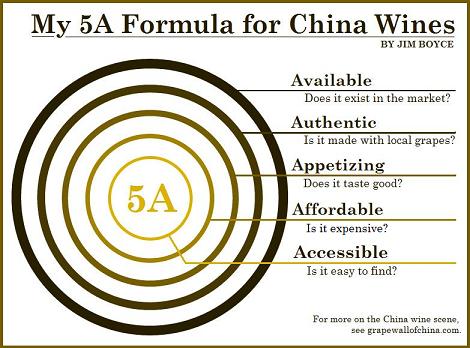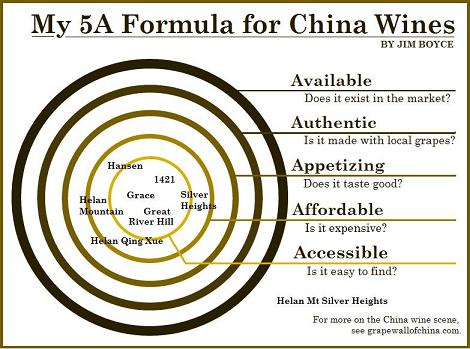
By Jim Boyce
Finding good Chinese wines is tough. True, hundreds of producers create thousands of wines in this country. Also true, few of those wines offer an attractive blend of quality, price and availability.
To illustrate my perspective as a consumer of Chinese wines, I created the 5A formula shown above. (Apologies for my poor design skills!)
I start with all of the wine sold under domestic labels (“available”). I then eliminate wines to keep those that are made with locally grown grapes (“authentic”), that taste good (“appetizing”) and that are reasonably priced (“affordable”). Finally, I consider if consumers can easily find these wines (“accessible”). It’s not a perfect system — some categories could be interchanged; a winery might produce both 5A wines and wines that score much lower; my perspective admittedly has a Beijing bias; and so on — but I think it offers one tool for sorting out which wines offer the most general appeal. (See the graphic at bottom for where individual wineries score using this formula.)
Of note, the biggest complaint about China wines from my readers is difficulty in finding them. We hear news of this or that wine getting an award — and we want to try it. But then we usually find production is only a few thousand bottles and/or the wine costs upward of rmb1000 (USD150 / Euro120) and/or there is no distributor. Things are slowly changing, aided by online sales and more mainstream retailers, bars and restaurants handling local wines, but the situation is nevertheless frustrating.
Anyway, as I wrote a few weeks ago, my tastings with consumers — and with restaurant, hotel and other trade folk who sell to consumers — are usually based on 5A wines:
I focus on select labels from producers like Grace from Shanxi, Hansen from Inner Mongolia, Great River Hill from Shandong and 1421 from Xinjiang. The goal is to use wines that are enjoyed by consumers (appetizing), have labels that sell for less than rmb150 or, ideally, less than rmb100 (affordable), and are available via retail chains or distributors with nationwide reach (accessible).
I used [5A] wines in April’s China Wine Tour and December’s Grape Wall Challenge, and use them in tastings with fellow consumers and trade people. I also use more expensive wines, such as those from Helan Qing Xue and Silver Heights (both from Ningxia), but usually for hotel and restaurant buyers creating a China wine list that already has [5A] options or for people yet to try Chinese wines and interested in what is available.
My sense is that as wine sales are now increasingly driven by consumers, rather than by official contracts, and as taste, rather than simply status, becomes a key factor for buying, we will see more and more 5A wines in the very near future.
~
The chart below includes the labels I tend to use for my tastings. I consider Grace, 1421 and Great River Hill as 5A since their entry-level wines are affordable, pass the taste test and are reasonably easy to find. Grace gets center spot based on the sheer size of its portfolio. Other producers come close to being 5A: Chateau Hansen and Helan Mountain are good but tend to be harder to find while Silver Heights and Helan Qing Xue make some of the better wines but are considered by many as pricey. All of these wines score above average in terms of 5A formula. There are hundreds of other wines that, if listed, would be on the outer fringes.
Note: The 5A formula is an extended version of my previous 3A formula.
Get more China wine news by signing up for my free e-newsletter here. Sample here. Follow Grape Wall on Twitter here.
Sign up for the Grape Wall newsletter here. Follow Grape Wall on LinkedIn, Instagram, Facebook and Twitter. And see my sibling sites World Marselan Day, World Baijiu Day and Beijing Boyce. Grape Wall has no advertisers, so if you find the content useful, please help cover the costs via PayPal, WeChat or Alipay. Contact Grape Wall via grapewallofchina (at) gmail.com.


Leave a Reply
You must be logged in to post a comment.